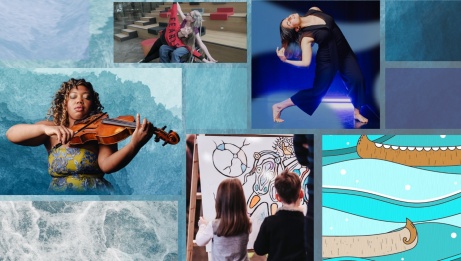A host of family activities will be offered on September 14 and 15 as part of the SPHERE Festival, including Navigating Tides, an interactive performance that uses music and movement to explore our relationship with water and our connection to the Earth’s ecosystem.
This 30-minute “choose your own adventure” work for strings and dance is an interactive performance that invites the audience to consider the changes, positive or negative, our actions can cause. The choices made by the audience influence the artistic storyline, mirroring the causes and effects of our decisions and showing that how we interact with water can either heal or erode our planet. Navigating Tides portrays our differences as much as our similarities. We are water, and water is us.
We spoke to Ottawa creators Kathryn Patricia Cobbler, loop pedal violist, visual artist and composer, and Elizabeth Emond-Stevenson, dancer and choreographer.
There will be three performances of Navigating Tides during the SPHERE Festival’s family day. Tell us about the show.
Elizabeth Emond-Stevenson: We decided to create Navigating Tides around finding identity, the connection between humans and water, and the cause and effect that is part of that relationship. As we’re working with an all-age audience, we decided to use movement to depict the character of water as well as humanity.
Kathryn Patricia Cobbler: We thought a lot about how we could use our two respective art forms to make the two characters interact. So we’re using music to represent the theme of water, and dance to portray certain themes of the human experience.
Why did you choose to explore our relationship with water and our connection to the Earth’s ecosystem?
K. P. C.: As artists, exploring the elements and how we’re connected to them is a wonderful opportunity. Water is essential to our ecosystem, our food, our way of life, but also to us. We were really interested in exploring this strong connection between humanity and water. If you look at the properties of water and those of the human body, they’re very different; yet we are water, and water is us. And that’s precisely the idea we want the audience to take away from the show: that we’re all different, but we’re also all the same, and that our actions have a direct impact on our relationship with the planet.
You were both pregnant during the creative process and rehearsals. Did that influence your work?
E. E.-S.: It was bound to influence it, especially as a dancer. I danced throughout my pregnancy, and with every movement I made, I felt the way my baby was reacting in its little sphere of water. I was extremely aware of all these changes, of the water and fluids inside me, which was particularly interesting given the theme of the work.
K. P. C.: Yes, it definitely influenced my composition a lot too. One thing I think about as an artist and as a mother is legacy—what we leave behind for the next generation. We make choices, sometimes good ones and sometimes ones that affect the environment. So what kind of legacy do we want to leave? How does our relationship with the planet and water affect not only our lives, but the lives of our children and our children’s children? That was very much on my mind during the process of composing the work.
In your work with your collective, Re: Imagine, you create multidisciplinary interactive shows that use music and movement to reanimate public spaces and encourage audiences to engage with them. What can we expect from Navigating Tides?
K. P. C.: Interactive shows let the audience experience the work in a different way. They become an integral part of the creative process, and that heightens the feeling of sharing a special moment. Because we knew there would be a young audience, we had to think about a way of working that incorporated accessibility. So the interactive element makes the program accessible to families, children, and neurodivergent people, by offering different ways of interacting. We like the idea that anyone who wants to can take part in the show.
E. E.-S.: Each performance of Navigating Tides will be unique, both for the audience and for us. Certain musical elements will remain constant, but others will be different depending on the choices the audience makes. We can’t wait to embark on this voyage and see where we land.
Thank you to The School of Dance and Ottawa Dance Directive for their generous support.




__tier1.png)




